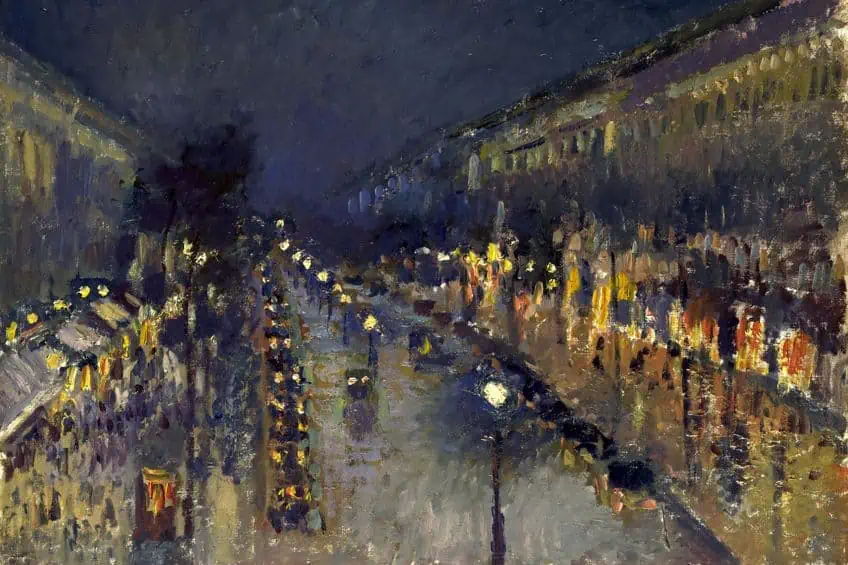Famous Cityscape Paintings – Examples of Great City Paintings
Cityscapes become the essential and iconic branding of a city that helps people not only identify a popular destination but also see the bigger picture and feel a sense of “home”. In this article, we will explore some of the most famous cityscape paintings in the world that have popularized the cities to which they belong and inspired artists to capture them with their paint brushes.
The Art of Cityscape Painting
The definitive feature of any cityscape lies in the arrangement of its buildings, which is usually portrayed against a skyline with a beautiful sunset. The origins of cityscape painting in art history find their way in ancient Rome and have since captured the attention of many well-known artists. For centuries, artists have looked to the sky and favorite cities for inspiration and have created some of the most famous cityscape paintings. The first cityscape from a Western art historical perspective is considered to be City by the Sea (c. 1340) by Ambrogio Lorenzetti, followed by other artists in European cities such as Johannes Vermeer, Claude Monet, and Camille Pissarro.
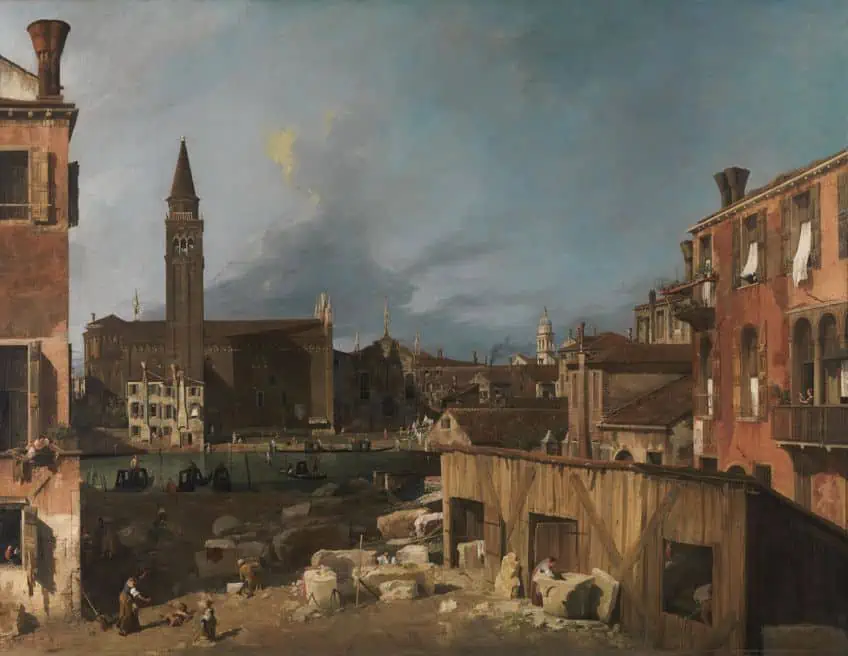
The Top 10 Most Famous Cityscape Paintings in Art History
The rise of cityscape paintings saw its height in the 20th century alongside the preference for conceptual art and Abstract Expressionism. The century also saw the introduction of American cityscape painting with many pioneering artists looking toward subject matter that revolved around the everyday. Avant-Garde practices also influenced the aesthetics of cityscape painting, which further propelled the evolution of the subject and its interpretation well into the Contemporary era.
Below, we will explore some of the most famous cityscape paintings that will have you longing to visit these destinations!
View of Delft (1660 – 1661) by Johannes Vermeer
| Artist Name | Johannes Vermeer (1632 – 1675) |
| Date | 1660 – 1661 |
| Medium | Oil on canvas |
| Dimensions (cm) | 98 x 118 |
| Where It Is Housed | Mauritshuis, The Hague, the Netherlands |
View of Delft is one of the most famous cityscape paintings created by Dutch artist Johannes Vermeer in the 17th century. Vermeer made an important impact on the history of cityscapes since the View of Delft became one of the rare artworks showing a cityscape at the time. Vermeer painted this cityscape from an elevated position, most likely from an upper portion of a house across the river Schie. It is also believed that Vermeer incorporated an optical device to aid his creation process and be able to render the finer details. The most gorgeous details lie in the reflection of the buildings and homes seen in the water with the cityscape set against a cloudy sky. Vermeer also produced other cityscapes such as The Little Street (1657-1658).
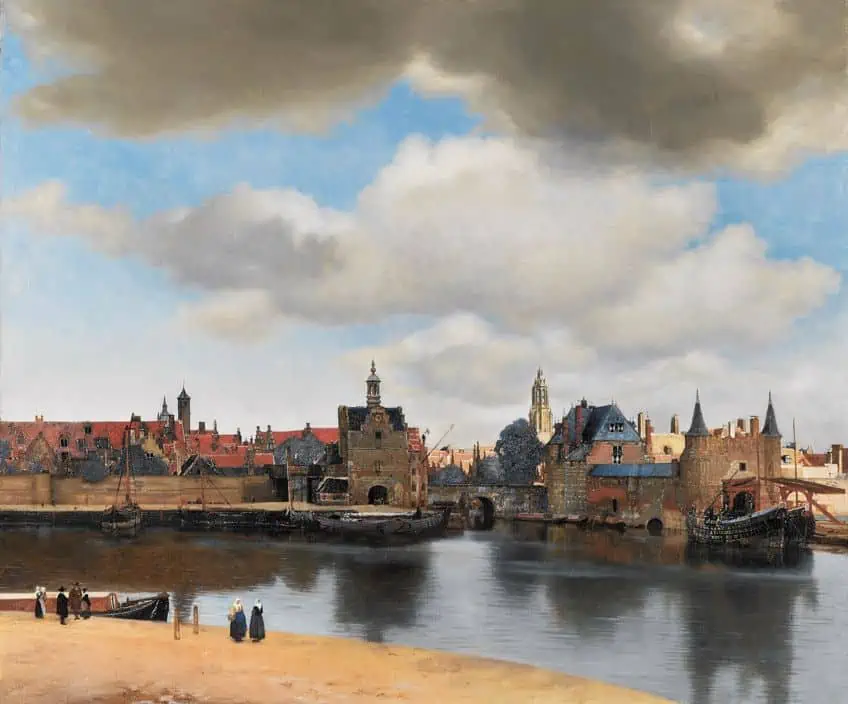
Evening in Cairo (1870) by Ivan Aivazovsky
| Artist Name | Ivan Aivazovsky |
| Date | 1870 |
| Medium | Oil on canvas |
| Dimensions (cm) | 110 x 134 |
| Where It Is Housed | Private collection |
Evening in Cairo is a cityscape that reflects the view of the urban environment in Cairo against a breathtaking orange sunset. The painting forms part of a controversial story surrounding its theft and sudden appearance at a 2013 auction at Sotheby’s, which was also unaware of the origin of the stolen painting.
The painting’s creator, Ivan Aivazovsky, is considered to be one of the most famous Russian Romantic painters in the world who specialized in maritime and landscape painting.
Boulevard des Capucines (1873 – 1874) by Claude Monet
| Artist Name | Oscar-Claude Monet (1840 – 1926) |
| Date | 1873 – 1874 |
| Medium | Oil on canvas |
| Dimensions (cm) | 80.3 x 60.3 |
| Where It Is Housed | The Nelson-Atkins Museum of Art, Kansas City, Missouri, United States |
This birds-eye view of a Parisian Boulevard portrays a crowded street painted with a blue hazy hue of the winter conditions. The scene is a famous cityscape painting created by one of the most celebrated artists in the history books, Claude Monet in the late 19th century. The scene was captured en plein air, which was the classic painting approach used by many Impressionists and involved the artist painting in the outdoor environment intending to complete the painting in one sitting. It is an impressive cityscape painting that truly demonstrates the fine-tuned abilities of Monet and his talents in Impressionist techniques.
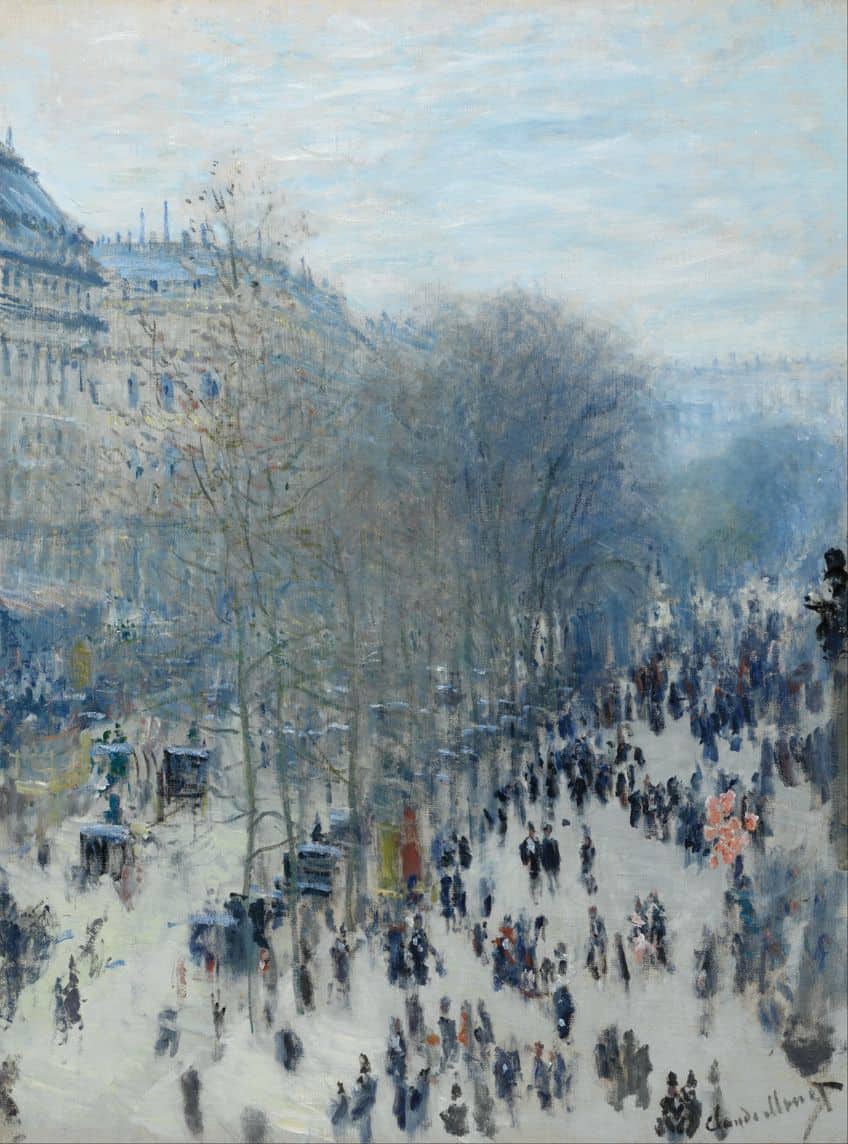
Paris. Rainy Day (1877) by Gustave Caillebotte
| Artist Name | Gustave Caillebotte (1848 – 1894) |
| Date | 1877 |
| Medium | Oil on canvas |
| Dimensions (cm) | 212 x 276 |
| Where It Is Housed | Art Institute of Chicago, Chicago, Illinois, United States |
Paris. Rainy Day is one of the most recognizable city paintings from the 19th century, created by French painting legend, Gustave Caillebotte. Caillebotte specialized in representing realistic images of Parisian scenes, which gave his paintings a contemporary edge. He was also inspired by the medium of photography and the Impressionist movement. Paris. Rainy Day shows a view of the city from a multipoint perspective on a rainy day. The primary angle from which it is taken is from a street view and places the viewer in front of the scene as if a part of the city itself. Caillebotte was somewhat theatrical in his approach to painting the city as he saw it. He was often influenced by the different art styles of his peers and this was reflected clearly in his work.
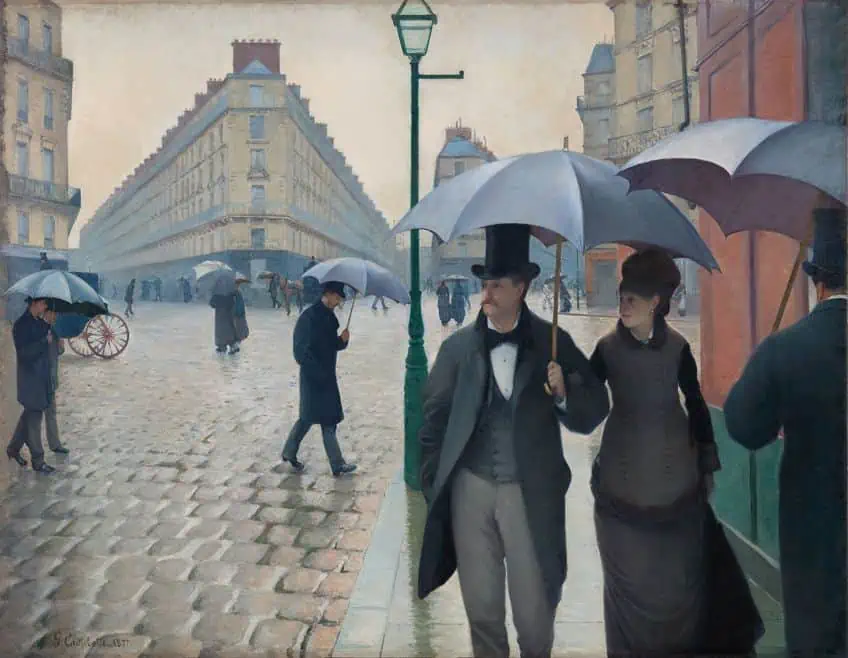
The Boulevard Montmartre at Night (1897) by Camille Pissarro
| Artist Name | Camille Pissarro (1830 – 1903) |
| Date | 1897 |
| Medium | Oil on canvas |
| Dimensions (cm) | 53.5 x 65 |
| Where It Is Housed | National Portrait Gallery, London, England |
The Boulevard Montmartre at Night is one of the most famous city paintings in art history created by one of the most famous French Impressionists, Camille Pissarro in 1897. This oil painting illustrates a view of the Boulevard Montmartre, captured from the window of a room at the Hôtel de Russie in Paris. Pissarro created this cityscape as part of a series of artworks aimed at capturing the urban environment at different times of the day. The Boulevard Montmartre at Night is the only painting with an evening sky of the series that demonstrates Pissarro’s mastery over his ability to illustrate an artificially-lit night scene in rainy conditions.
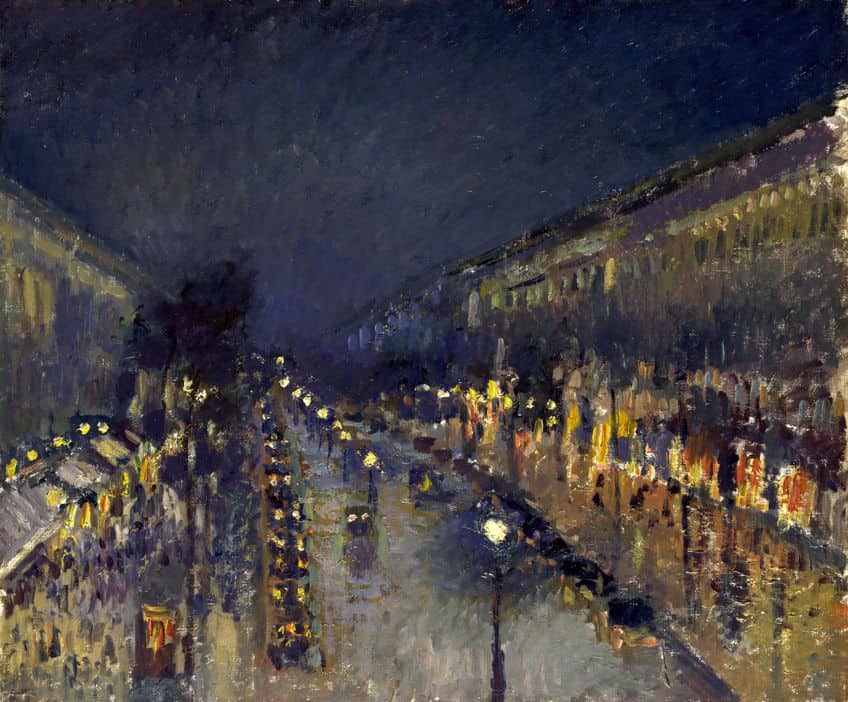
Paris Through the Window (1913) by Marc Chagall
| Artist Name | Marc Chagall (1887 – 1985) |
| Date | 1913 |
| Medium | Oil on canvas |
| Dimensions (cm) | 136 x 141.9 |
| Where It Is Housed | Solomon R. Guggenheim Museum, New York, United States |
This colorful cityscape was created by Russian-French multi-talented artist, Marc Chagall who moved from Russia in 1910 and was inspired by the emerging Parisian Avant-Garde styles. Paris Through the Window illustrates the influences of Orphic Cubism, which was introduced to Chagall through his acquaintance, Robert Delaunay. Orphic Cubism was a style that emerged in 1912 and was a derivative of the traditional Cubist style focused more on introducing abstraction and bright color into Cubist works. This is seen in the vivid colors on the window, the cat, behind the Eiffel tower, and the Janus-faced man.
Gordon’s Gin (1968) by Richard Estes
| Artist Name | Richard Estes (1932 – Present) |
| Date | 1968 |
| Medium | Oil on canvas |
| Dimensions (cm) | Unavailable |
| Where It Is Housed | Unavailable |
Richard Estes is one of the most well-known 20th-century cityscape painters who created this iconic cityscape featuring an iconic New York scene with a giant billboard advertising the popular Gordon’s Gin. Estes’ interest in cityscapes included scenes from Paris, Manhattan, Venice, and Chicago. His cityscape paintings always appear in broad daylight as clean scenes without any urban pollution, which reinforces his utopian urban city aesthetic of the old New York City, characterized by some of its most loved brands. Estes is also recognized as one of the pioneers of Photorealism, working from freehand and photographs to paint highly detailed cityscapes.
Valley Streets (2003) by Wayne Thiebaud
| Artist Name | Morton Wayne Thiebaud (1920 – 2021) |
| Date | 2003 |
| Medium | Oil on canvas |
| Dimensions (cm) | 121.9 x 152.4 |
| Where It Is Housed | San Francisco Museum of Modern Art, San Francisco, California, United States |
This colorful multi-point perspective cityscape painting was created by Wayne Thiebaud and now forms part of the permanent collection at the San Francisco Museum of Modern Art. Thiebaud is most famous for his confectionary paintings, which emulate a similar style to that of his cityscapes in terms of his color palette. The San Francisco cityscape is presented in such a way that one catches a glimpse of multiple perspectives from a rooftop.
The cityscape is not just horizontal, but it also carries depth to the height of a city, which is unique considering that most cityscapes focus on the city against the sky in a “bigger picture” grandiose way. Valley Streets offers a closer view of the minute details of San Francisco despite presenting itself as a large, busy city.
Desierto Leones; Mexico City (2007 – 2009) by Vladimir Milivojevic
| Artist Name | Vladimir Milivojevic (1969 – Present) |
| Date | 2007 – 2009 |
| Medium | Photography |
| Dimensions (cm) | Unavailable |
| Where It Is Housed | Unavailable |
Desierto Leones is part of a series of cityscape photographs taken by Vladimir Milivojevic, also known by his artist name, Boogie, who is currently based in New York City. Boogie began his photography journey by documenting the civil unrest of the 1990s and captured the “darker” effects of unrest and undocumented areas of the city that shed light on the genre of cityscapes. Boogie also focuses on documenting scenes that are raw and therefore powerful images that give viewers insight into a city as opposed to its mere aesthetic of it.
The genre of street photography is key to unlocking unseen “cityscapes” that are not only defined by the traditional aesthetic of a row of buildings against a beautiful sunset or atmosphere but rather, by the character and nature of the city within it.
Bad Seeds (2019) by Ana Schmidt
| Artist Name | Ana Schmidt |
| Date | 2019 |
| Medium | Acrylic on canvas |
| Dimensions (cm) | 161.9 x 113.9 |
| Where It Is Housed | Private collection |
Ana Schmidt is an acrylic artist and architect who focuses on exposing urban landscapes through painting. Bad Seeds highlights the parts of a city that go overlooked and are not necessarily considered “beautiful” or appealing to a tourist’s eye. The acrylic painting is rendered in such incredible detail that it almost mimics the visual quality of a photograph. Schmidt’s illustration of the water and the light reflecting off the puddle is also an aspect to admire. Her illustration of the “in-between” of a city evokes a need to reassess the detours and details of life in the city and how neglect can co-exist in spaces otherwise perceived to be organized and fast-paced. The urban landscape is a complex environment that offers more than just a space for reflection. It also provides insight into the ways that we construct spaces for movement and occupation as well as how these urban spaces affect our modern visual language and culture.
The urban environment can be represented in so many ways that highlight just how complex it is. A cityscape offers more than just an escape from the minute realities that it holds while also superimposing the unseen elements of a city that inform its character. We hope that you have enjoyed exploring the different city paintings that continue to reframe the way that one thinks about a city and its defining aesthetics.
Frequently Asked Questions
What Is the Meaning of Cityscape Art?
When looking at cityscape art, its meaning is tied to the defining visual aesthetics of a city often featured in landscape artworks and inspired by vertical and horizontal views of different viewpoints of a city. Cityscapes are also recognized as urban landscapes in art and feature the different components of a city such as its architecture, structure, buildings, and streets.
What Is the Most Famous Cityscape Painting?
The most famous cityscape painting is considered to be Paris Street. Rainy Day (1877) by Gustave Caillebotte. It is a multipoint perspective painting of a rainy day in Paris.
Are Cityscape Paintings Contemporary?
Cityscape paintings are considered to be contemporary, however, they have existed for centuries and are not limited to the contemporary period in art history. Urban landscape paintings are considered a modern and contemporary genre of art.
Nicolene Burger, a South African multimedia artist and creative consultant, specializes in oil painting and performance art. She earned her BA in Visual Arts from Stellenbosch University in 2017. Nicolene’s artistic journey includes exhibitions in South Korea, participation in the 2019 ICA Live Art Workshop, and solo exhibitions. She is currently pursuing a practice-based master’s degree in theater and performance. Nicolene focuses on fostering sustainable creative practices and offers coaching sessions for fellow artists, emphasizing the profound communicative power of art for healing and connection. Nicolene writes blog posts on art history for artfilemagazine with a focus on famous artists and contemporary art.
Learn more about Nicolene Burger and about us.
Cite this Article
Nicolene, Burger, “Famous Cityscape Paintings – Examples of Great City Paintings.” artfilemagazine – Your Online Art Source. February 6, 2023. URL: https://artfilemagazine.com/famous-cityscape-paintings/
Burger, N. (2023, 6 February). Famous Cityscape Paintings – Examples of Great City Paintings. artfilemagazine – Your Online Art Source. https://artfilemagazine.com/famous-cityscape-paintings/
Burger, Nicolene. “Famous Cityscape Paintings – Examples of Great City Paintings.” artfilemagazine – Your Online Art Source, February 6, 2023. https://artfilemagazine.com/famous-cityscape-paintings/.


